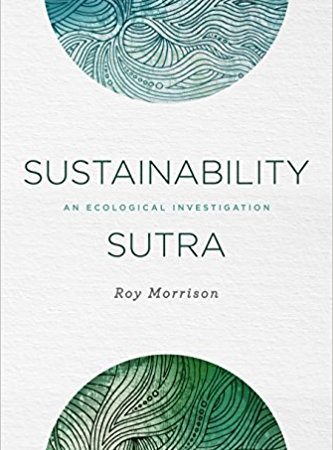A Review of Roy Morrison’s book, Sustainability Sutra: An Ecological Investigation
In my Foreword to Roy Morrison’s new book Sustainability Sutra (SelectBooks, Inc., New York, 2017) [full disclosure, Roy is a friend and close colleague] I urged everyone to read this important new work, “a treatise of earnest and telling sobriety, informed by brilliant reasoning and resonant scientific and economic meditation.” Jane Morrison (no relation to the book’s author) and I first met Roy at the World Cultural Forum in Hangzhou, China in 2013 where he gave a plenary address that helped illuminate the “Hangzhou Declaration,” “a global call for building an ecological civilization in the face of grave environmental challenges.” Morrison has long been at the forefront of the alternative energy revolution.
But for decades there has existed widespread skepticism amongst many scientists, but particularly biologists, paleontologists and atmospheric chemists that we do not have as a species what it takes to overturn our out-of-control consumption, usurpation of habitat, killing of other species, felling of vast amounts of forest, destruction of the oceans, of virtually every biome, while simultaneously mounting an all-out human affront – or war against the Earth – by our sheer proliferation of consumers.
Their collective assault on the planet’s carrying capacity threatens a “replay of the Paleocene-Eocene Thermal Maximum (PETM) of 55 million years ago, risking a very likely catastrophic end to global civilization.” (*1) The PETM represented a 200,000-year-period in which excessive amounts of carbon dioxide were infused into the atmosphere and troposphere, creating a cybernetic hell for a large number of terrestrial organisms; a disaster mirrored by our present surge beyond the 400 parts per million of CO2 injected by our current industrial paradigms into the atmosphere.
But the primary fuel of this ultimately biological crisis is a deep demographic engine – not unlike a W16 engine roaring on all cylinders; a mindless fertility rate, and built-in population explosion most recently reflected in a lawsuit filed in federal court by the Immigration Reform Law Institute against the U.S. Department of Homeland Security “for failure to properly comply with the National Environmental Policy Act (NEPA).” (*2) The essence of this lawsuit hinges upon the fact that NEPA (instituted January 1, 1970) requires of each and every federal agency environmental accountability, and claimants most assuredly include individual human beings, whose environment may be affected adversely by a federal action. According to Leon Kolankiewicz’s research, “America’s total population is projected to increase to 441 million by 2065 – an increase of more than 115 million from our 2016 population. [And] Demographers estimate that immigration will account for 88 percent of this growth.” (*3) This, in turn, will likely impact indigenous biodiversity and habitat by “1.2 to 2.2 times greater than they are [impacted] at present.” (*4)

Such escalations of converging ecological bad news in just one country out of 196+ nations, does not bode well for anything like sustainability. Roy Morrison is deeply in touch with all of this environmental carnage, yet somehow has managed, both by his lyrical optimism, and adroit technical insights, to envision numerous plausible scenarios by which our species still has legitimate grounds for thinking and acting positively to stem the biological hemorrhaging. Sustainability Sutra is ingeniously woven, as if poets and ecologists had worked together to formulate a game plan for the future of human life on earth that makes of the complex puzzle a solutions- and science-driven story at once compassionate and tenable, as unlikely as that may sound. In his Introduction, Morrison remarks upon the great Rabbi Hillel who “was asked to explain the meaning of Torah while he was standing on one foot. He replied, ‘What is hateful to you, do not do to your neighbor. The rest is commentary.’” (*5)
Morrison’s own commentary reads with a cumulative urgency that is largely focused upon two of his most trenchant areas of particular expertise: renewable energy strategies and the formidable economics and technologies attendant upon the strenuous reduction of human greenhouse gas emissions worldwide while, at the same time, greatly reducing that insufferable gap between rich and poor. He situates this conundrum under the banner of “Fiduciary Responsibility in the 21st Century” (*6) and writes that such responsibility “must come to mean the improvement of the bottom line, that is, the growth of finance capital, and the regeneration of natural capital, and the application of measures to systematically reduce poverty and transfer resources from rich to poor.” (*7) Of course, we have heard such ecological mandates before; actually, from a plethora of well-informed analysts in countless disciplines and thousands of peer-reviewed papers and books. What makes Morrison’s work stand out, in our opinion, are the invigorating selection of existing templates he has chosen to demonstrate a thesis that is at once poetic, spiritual (hence, the partial form of a sutra) and technical.
Among scores of examples, Morrison cites the state of Louisiana’s “residential tax credit for installing solar energy systems”… “the best in the nation” (*8); and, upon a litany of data from that state, adds in the sutra section that follows each of the 27 investigative technology/science chapters of the book, a meditative conclusion. So, in response to all the numbers, dollars and cents, incentives and outlooks for a sustainable energy future in a state hit hard by the BP disaster (Morrison and his wife and son actually traveled to Louisiana in the wake of that oil disaster to offer their humble assistance in the goal of cleaning oil-soaked birds, witnessing pervasive pollution and poisoning on a monumental scale) he writes, “Life is poetry…. Civilization is the unexpected fruits of desire manifest, self-consciousness escaping traditional limits and leaping towards new beginnings…. An ecological civilization employs these social, political and economic means to release the Gordian knot binding civilization to ecological self-destruction. This is not a mystery or technological magic, but the fruits of the chosen pursuit of sustainability….” (*9)
Morrison prompts readers to reflect on a much deeper level than is customary when it comes to assessing goods and services in terms of taxes as calibrated according to whichever pollution index one cares to recognize. He suggests that our existing system of taxing negatives (e.g., a cigarette tax) must actually hinge upon “an assessment on the value of all goods and services based on the level of sustainability…. The price system can be made to work for us, and not against us.” (*10). This, in turn, inexorably calls upon the “potential for ecological value-added taxes” (*11) which Morrison examines in depth in the case of China’s current VAT, Consumption Tax and Business Tax, concluding that, despite its flaws, a new wave of ecological taxation philosophy has percolated to the highest levels of Chinese legislation. “In June 2015, China Legislative Affair’s Office issued a draft environmental taxation law on air, water, noise, and solid waste pollution that includes specific rates on pollution.” (*12) And, citing Jia Kang, China’s head of the Ministry of Finance’s Research Institute for Fiscal Science, he writes, “Purely relying on traditional administrative interventions is clearly no longer adequate to deal with the current problems.” (*13) Indeed, China has now embraced a system that imposes “criminal and civil penalties on polluters.” (*14) This is a precursor to Morrison’s “sutra” which he cannily titles, “Sustainability And The Biosphere’s System State Sutra,” (*15) by concluding, “Sustainability is the awareness and dynamic balance of human power and human vulnerability. Sustainability is the emergent social practice and social theory of the 21st century, guiding and impelling the transformation of an industrial to an ecological civilization.” (*16)
Morrison moves from commentary on India’s embrace of a plan to install “100,000 megawatts of solar PV by 2022” (*17) to an analysis of the differences between the notions of “freedom and community” as articulated by the philosophers John Rawls (1921-2002) and John Stuart Mill (1806-1873). Rawls’ book A Theory of Justice (1971) never mentions “community” – a fact that segues to a situation whereby “people somehow aren’t aware of their circumstances and therefore don’t know whether or not they will benefit or suffer from a decision.” (*18) Conversely, Mill fundamentally considered “the relationship between freedom and community.” (*19)
That dynamic – the individual and the community – takes on biosphere proportions almost at once throughout Morrison’s treatise; whether in assessing Con Edison in New York, or Pacific Gas and Electric Company in California. The underlying thesis that resonates throughout his energy-specific “smart network” thrust is the great need in every country for “net metering.” (*20) Writes Morrison, “The real problem is a 20th century revenue model threatened by 21st century renewable, efficiency, and smart-grid technology. The answer for utilities and regulators is what PG&E and California understands – sell more efficient renewable electricity and be able to make money as operator and facilitator of the smart grid.” (*21)
Morrison’s conclusions emerge as hugely doable solutions throughout this splendid, must read book. Of particular note is his explanation of the functionality of BEE (Basic Energy Entitlement) which, he writes, “is a means for transferring capital from high-energy users to low-energy users, and from rich to poor, both between and within nations.” (*22) He lays out vivid depictions of British Thermal Units and their kilowatt equivalencies, down to the burning of a match, and then elevated by civilization to “quite a little bonfire.” (*23) The way he merges such mechanisms as a “Basic Income Guarantee,” global BEE investment opportunities, particularly in OECD nations, “successful entrepreneurial pilot projects,” (*24) such as “the world’s largest vertical farm” in Newark New Jersey (*25) and those market systems that empower “ecological tax transformation” (*26) all combine to suffuse Morrison’s exemplary book with a tough, resilient and realistic edge.
Sustainability Sutra quickly bypasses sheer anxiety and combs a lavish array of exceptional alternatives to the dark tunnel in which so much of humanity now finds itself, aware or unaware of the disastrous ecological unraveling we are solely, as a species, perpetrating. Morrison’s well-documented thesis concludes with a “Global Tour: Places Working to Get It Right” (*27) which encompasses (in addition to some already mentioned herewith) Vermont’s House Bill 40, mandating 55 percent renewables by 2017, 75 percent by 2032; the PV market in Chile; efficiency standards in Japan; Indonesia’s new forestry moratorium; and sustainability planning – district by district – across Copenhagen. Poetically, Morrison concludes, “The pursuit of sustainability is the path toward doing good and well. It does not demand perfection, but self-conscious action and the artful dance and feedback of continuous correction.” (*28)
We urge everyone to read Sustainability Sutra, and share it with everyone you know. More information about how you can find the book is below.
By Michael Charles Tobias & Jane Gray Morrison
Sustainability Sutra is available for purchase through: Books-A-Million, Barnes & Noble, and Amazon.
You can also find a local bookstore through IndieBound or see if it is available at your local library.
Footnotes:
1) ibid., p.109.
2) See “An Environmental Impact Statement on U. S. Immigration Levels,” by Leon Kolankiewicz, CAPS ISSUES, January, 2017, p.1.
3) ibid.
4) ibid., p.3.
5) Morrison, pp.1-2.
6) ibid., p.19.
7) ibid., p.19.
8) ibid., p.40.
9) ibid. pp. 44-45.
10) ibid., pp. 192-193.
11) ibid., p.195.
12) ibid., p.197.
13) ibid., p.197.
14) ibid., p.197.
15) ibid., p.198.
16) ibid., p. 199.
17) ibid., p. 201.
18) ibid., p. 81.
19) ibid., p.83.
20) ibid., p.97.
21) ibid. p.97.
22) ibid., p.143.
23) ibid., p.142.
24) ibid., p. 155.
25) ibid., p.223.
26) ibid., p. 185.
27) bid., pp.219-225.
28) ibid., p. 229.
The views and opinions expressed through the MAHB Website are those of the contributing authors and do not necessarily reflect an official position of the MAHB. The MAHB aims to share a range of perspectives and welcomes the discussions that they prompt.

